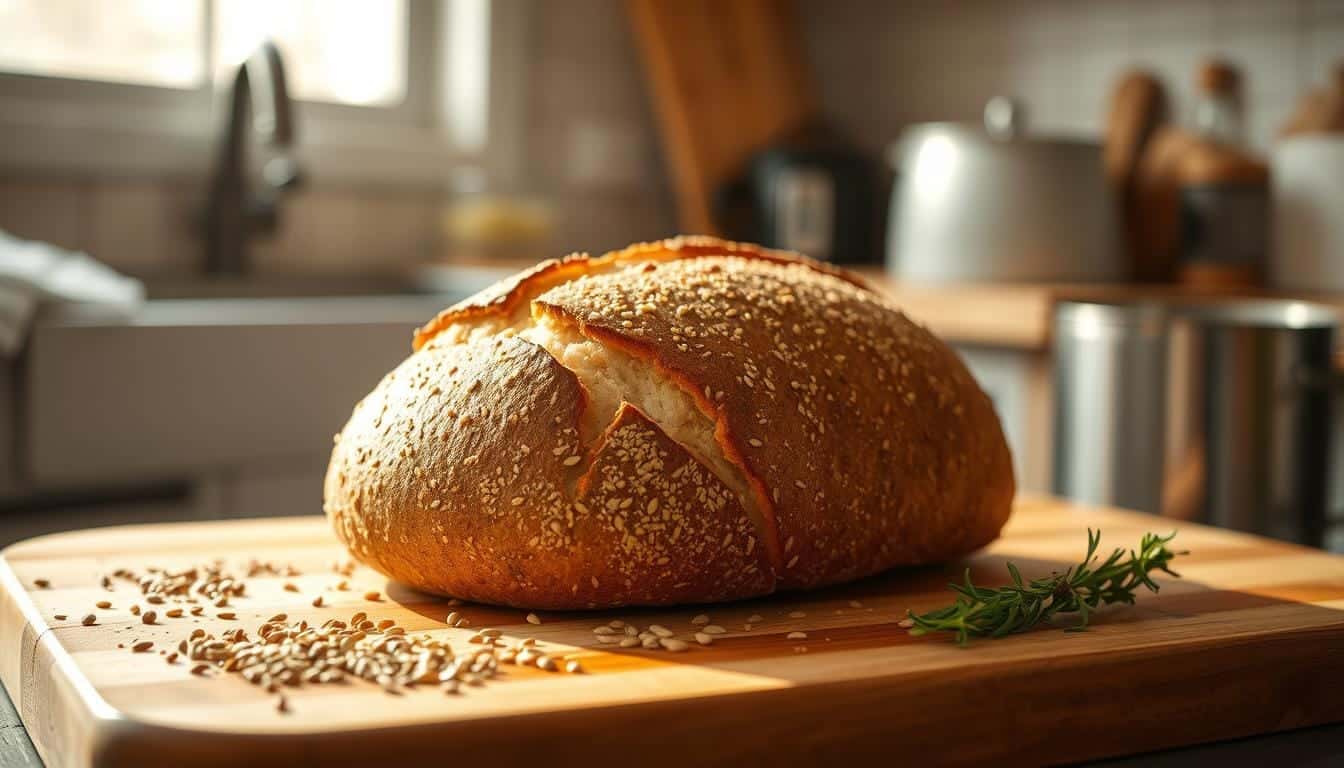Easy Ezekiel Bread Recipe: Healthy Homemade Bread

There’s something special about the warmth of freshly baked bread. It’s even better when it’s made with ingredients that nourish your body. Imagine pulling a dense, golden loaf from your oven, knowing every grain and sprout in that ezekiel bread recipe supports your health goals.
This isn’t just bread—it’s a blend of grains and legumes activated through sprouting. It turns simple ingredients into a powerhouse of protein and fiber.
Whether you’re gluten-free, plant-based, or just craving wholesome flavors, this ezekiel bread recipe is for you. No complicated steps here—just a simple guide. You’ll turn sprouted grains like barley, millet, and lentils into a versatile base for sandwiches, toast, or even breadcrumbs.
Let’s make baking this nutrient-rich loaf as easy as mixing ingredients. Just wait for time and heat to work their magic.
Table of Contents
Overview of Ezekiel Bread: A Nutritious Alternative
Ezekiel Bread is a new twist on traditional bread, combining ancient wisdom with modern nutrition. It’s made with whole soybeans, barley, and lentils, avoiding processed ingredients. For those looking for healthy bread recipes, it’s a protein-rich choice compared to refined flour.
Nutritional Advantages
Sprouting grains makes them easier to digest, enhancing nutrients like fiber and B vitamins. Compared to white bread, Ezekiel Bread has twice the protein and no added sugars. Its benefits include:
- Higher amino acid content from sprouted legumes
- Natural enzymes improving nutrient absorption
- Lower glycemic index for stable energy levels
The History and Benefits
“Take wheat, barley, beans, lentils, millet, and spelt…” — Ezekiel 4:9 (NIV)
This verse inspired today’s healthy bread recipes. Unlike commercial breads, Ezekiel Bread uses unprocessed ingredients. Its popularity shows people want foods that support wellness without additives.
Key Nutrients & Health Benefits of Ezekiel Bread
Homemade ezekiel bread is more than a recipe; it’s a treasure trove of nutrients. Each slice is packed with protein, fiber, and vital vitamins that boost your health. The sprouted grains and legumes in it offer complete proteins, making it a favorite for vegetarians and health enthusiasts.
- Protein: Lentils, soy, and barley provide amino acids your body can’t make.
- Fiber: 5-6 grams per slice helps with digestion and keeps you full.
- Vitamins: B vitamins like folate boost energy naturally.
- Minerals: Iron and magnesium support immunity and muscle function.
The sprouting process makes nutrients more accessible to your body. Unlike refined breads, homemade ezekiel bread has a low glycemic index. This helps keep blood sugar stable. Its fiber content also supports gut health by feeding good bacteria.
By baking it yourself, you avoid additives and control salt and sugar. Adding this bread to your diet can give you lasting energy and better nutrient absorption. Every batch you make is a step towards nourishing your body with whole foods.
Essential Ingredients for Homemade Ezekiel Bread
Mastering the ezekiel bread ingredients is key to making a loaf that’s both nutritious and tasty. Let’s explore what makes this recipe special.
Whole Grains versus Sprouted Grains
Sprouted grains are the heart of Ezekiel bread. They’re different from whole grains because they’re germinated first. This process increases their enzyme activity and nutrient absorption.
Choose certified organic sprouted wheat, barley, and millet for the best results.
Understanding Ezekiel Bread Ingredients
Traditional recipes combine these main ingredients:
- Sprouted wheat berries
- Sprouted barley and millet
- Sprouted lentils (yellow and green)
- Sprouted spelt
- Sprouted soybeans
These ingredients help make a gluten-free option when using brands like Food For Life. Always look for “sprouted” labels to ensure quality.
Choosing the right ezekiel bread ingredients is crucial for high protein and fiber. Don’t use pre-ground flours. Sprouted grains should be freshly milled for the best nutrition. Also, include milled amaranth and quinoa for the right texture.
Kitchen Preparation & Equipment for Easy Bread Recipes
To make homemade whole grain bread, start by getting the right tools. Use a flour mill or high-speed blender to break down sprouted grains well. This ensures your bread has an even texture.
Choose loaf pans made of glass or stainless steel for the best results. You’ll also need mixing bowls, a dough scraper, and a clean work surface.
- Flour mill or stand mixer attachment
- Non-stick loaf pans (8.5×4.5 inches)
- Thermometer for monitoring dough temperature
- Proofing basket or clean kitchen towel
Keep your ingredients and tools within reach to avoid any hiccups. A warm, draft-free spot is perfect for letting the dough rise. Use a digital scale for accurate measurements, as sprouted grains need exact ratios.

Some kitchens might need a proofing box or humidity tray. But, a simple method uses a preheated Dutch oven. Make sure your hands are clean and lightly floured to prevent sticking during kneading.
Test the dough by gently pulling it. If it’s elastic yet soft, it’s ready.
For storing leftovers, use airtight but breathable containers, like parchment-lined ones. Avoid plastic wrap to keep the bread moist without it getting soggy. Proper preparation ensures your whole grain bread rises well and tastes nutty.
Mastering the ezekiel bread recipe: A Comprehensive How-To Guide
Transform your kitchen into a bakery with this detailed guide. Follow each step closely to master one of the best easy bread recipes. This will lead to perfect results.
Step-by-Step Guide to Making Ezekiel Bread
- Activate yeast: Mix warm water (105–110°F) with yeast. Wait 5–10 minutes for it to become foamy.
- Mix dry ingredients: Put sprouted grains, vital wheat gluten, and additives in a big bowl.
- Slowly add wet and dry mixtures. Stir until a dough forms.
- Knead the dough on a floured surface for 8–10 minutes until it’s elastic.
- Let the dough rise in a greased bowl until it doubles (1–2 hours in a warm place).
- Shape the dough into a loaf pan. Let it rise again for 30 minutes.
- Bake at 350°F for 30–40 minutes until the crust is golden brown.
Mixing, Kneading, and Rising Techniques
Creating perfect dough needs careful mixing. Start with a wooden spoon, then knead by hand for texture. Warmth is key: keep dough in a draft-free area, like an oven with just the light on.
Don’t over-knead, as it makes dough tough. Stop when it passes the “windowpane test.”
Aim for a dough that’s sticky but easy to handle. Add flour slowly if it’s too wet.
Be patient during rising phases for a fluffy crumb. Over-rising causes collapse, while under-rising makes bread dense. Test dough by pressing gently—if the indent stays, it’s ready.
Customizing Your Homemade Ezekiel Bread: Advanced Bread Baking Tips
Make your spouted grain bread even better by trying new flavors and textures. You can add sweetness, savory tastes, or a crunchy bite. Small changes can turn your bread into something special, just the way you like it.

Flavor Variations
Try these to add bold or subtle tastes to your bread:
- Cinnamon and raisins for a warm, sweet flavor
- Crushed garlic or sage for a savory taste
- Seeds like sesame, poppy, or caraway for a nutty crunch
- Herbs such as rosemary or thyme for earthy notes
For a rich autumn flavor, mix spiced sprouted grain bread with pumpkin seeds and blackstrap molasses.
Texture Adjustments
Change the dough’s texture by balancing add-ins:
“Spices like fennel or caraway seeds keep the bread moist, making it softer. Too much salt or strong spices can slow down yeast, so start small.” – Culinary Science Institute
For a denser bread, add rolled oats or flaxseed. For a lighter loaf, use less salt and don’t overmix after adding spices. Adjust the amount of sprouted grains to get the crumb you want.
Remember, grains like barley or quinoa change the texture. Test small batches to find your perfect mix.
Vegan & Low Carb Variations for Healthy Bread Recipes
Try vegan bread recipes for a healthier option. You can replace eggs and dairy without losing texture. Use flaxseed or chia seeds instead of eggs, and almond or oat milk for dairy.
- Vegan swaps: Coconut aminos for soy sauce, maple syrup for sweetness, and aquafaba for moisture.
- Low-carb options: Mix almond or coconut flour with regular flour. Use erythritol for sugar and cauliflower rice flour to reduce carbs.
Add sunflower seeds or nutritional yeast for extra flavor. Alternative flours might need more liquid. Make sure the dough is just sticky enough.
Choose high-protein flours like buckwheat or quinoa for vegan bread recipes. You might need more liquid when cutting carbs. Keep leftovers in a sealed container for up to 3 days or freeze for longer.
Troubleshooting Common Issues in Bread Baking
Even skilled bakers face setbacks, but these bread baking tips help turn mistakes into perfect loaves. Let’s tackle the most frequent hurdles and how to resolve them.
Identifying Baking Pitfalls
Recognize these red flags early:
- Dense or brick-like texture
- Under-risen dough that doesn’t expand
- Dough too sticky or dry
- Cracked or uneven crust
Effective Correction Strategies
Follow these steps to fix issues as they arise:
- Weak rise? Check yeast viability. Warm water (95–110°F) activates yeast—cold temps stall growth. Proof yeast in liquid first to confirm it’s active.
- Too dense? Adjust kneading time. Under-kneaded dough lacks gluten structure; over-kneaded becomes tough. Aim for a smooth, elastic dough.
- Sticky dough? Add flour gradually. Overly wet dough needs small flour additions while kneading, but avoid overcompensating.
- Uneven crust? Preheat the oven and pan. A hot pan promotes even expansion, while steam (from a spray bottle) creates crisp crusts without cracks.
Mastering these bread baking tips transforms troubleshooting into a routine part of your process. Practice patience and precision, and each loaf will improve.
Storing and Enjoying Your Freshly Baked Ezekiel Bread
Keeping your homemade Ezekiel bread fresh is easy. For those who love low carb bread recipe, here’s what to do:
- Slice the bread fully before storing to prevent sogginess.
- Wrap tightly in parchment paper first, then place in an airtight container.
- Store at room temperature for 2–3 days or freeze for up to 3 months.
Freezing is the best way to keep it fresh for a long time. Let it thaw at room temperature before you use it. To make it crispy again, reheat slices in a toaster or oven.
Try it in different ways. Crumble it into salads for extra crunch or blend into breadcrumbs for coatings. It’s great with soups or as a gluten-free base for open-faced meals. Always store leftovers right away to keep it fresh.
Conclusion
The recipe for Ezekiel bread is a mix of tradition and nutrition. It starts with sprouting grains and ends with a healthy loaf. This bread is packed with protein, fiber, and vitamins, making it a better choice than refined breads.
Getting the bread right is all about the right amount of water and kneading. If it’s too dry, try baking it for a bit longer or add more water. Store it in airtight containers or freeze it for later. You can enjoy it toasted with avocado or in sandwiches.
Try different versions of the recipe for Ezekiel bread like flax or sesame sprouted ones. It’s high in fiber and has antioxidants that help with digestion and reduce inflammation. Keep practicing to make a bread that fits your healthy eating goals.
FAQ
What is an Ezekiel bread recipe?
What are the health benefits of homemade Ezekiel bread?
What ingredients are required for Ezekiel bread?
How do sprouted grains differ from whole grains?
What kitchen equipment is needed to make Ezekiel bread?
Can I make vegan versions of Ezekiel bread?
What are some common issues when baking bread, and how can I fix them?
How do I store my homemade Ezekiel bread?
Is there a low carb way to make Ezekiel bread?
How can I customize the flavor of my Ezekiel bread?
How did you like the recipe?
There are no reviews yet. Be the first one to write one.
